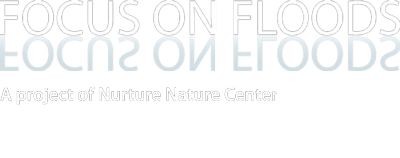Current Studies:
Research Study of Communities Vulnerable to Flooding This research advances NNC’s model of focus group and survey testing to reach underserved audiences in various regions across the country, including low-income urban, rural, and tribal communities not previously studied. It looks at a broad suite of probabilistic and other flood forecast tools for both riverine and flash flood risk and includes partnering River Forecast Centers, Weather Forecast Offices, and local community-based organizations to identify and engage with diverse audiences in regions across the country to understand how residents receive, use, and understand flood forecast information to improve the flood products themselves and the communication channels used to share them. In the project, “Expanding Audiences, Removing Barriers, Promoting Action: Addressing the diverse needs of audiences for flood forecast information”, we are conducting focus groups in partner regions across the country, including the Pocatello, ID Weather Forecast Office, Wilmington, NC Weather Forecast Office, North Central River Forecast Center, Missouri Basin River Forecast Center, and Middle Atlantic River Forecast Center areas. (Funded via NOAA Award Number NA22OAR4590170, September 1, 2022).
Research Study of Weather Prediction Center Precipitation Products and Website Our broadest scope of work to date, “Improving Delivery of Weather Prediction Center Precipitation Products” is a multi-phase social science research study that will provide user testing and recommendations for refinement of precipitation products in partnership with the Weather Prediction Center (WPC) at NOAA. NNC will conduct interviews, focus groups, and surveys to test the WPC rainfall products with professional user audiences and to test the prototype of a new Urban Rain Rate Dashboard (URRD) in several of the thirty largest metropolitan areas in the country. Concurrently, NNC is partnering with Fountain Digital Consulting to perform a web usability study of the WPC website. The study will provide recommendations of 1) changes to precipitation products and their delivery to professional stakeholders, 2) suggested content and design for the URRD based on potential user feedback, and 3) design, structure, and content suggestions for the new WPC website. (Funded via NOAA Award Number NA23OAR4590137, February 1, 2023).
Research Study of Flood Inundation Mapping Flood extent and inundation maps are a common way to communicate flooding risk, but there is little research on such products’ content, design, dissemination best practices, and use in decision-making. The National Weather Service aims to have an operational Flood Inundation Mapping (FIM) for 10% of the US population in 2023 and for 100% of the US population by 2026. NNC will conduct a social science research project about FIM products with focus groups in the Mid-Atlantic River Forecast Center area (State College, PA and Binghamton, NY areas) and the West Gulf River Forecast Center area (Houston area). This research, “Making FIMs Work for Multiple Users: Understanding the Value and Function of Flood Inundation Mapping to Support Decision Support”, will provide critical insight into how FIM products support decision making related to flooding and will collect data from key stakeholders to improve product delivery and design. (Funded via NOAA Award Number NA23OAR4590359, August 1, 2023).
Development of a Longitudinal Flood Survey Working with the University of Oklahoma’s Institute for Public Policy Research and Analysis, which implements Extreme Weather and Society Surveys on several topics, NNC will develop a new annual flood survey to provide generalizable data on the extent to which members of the US public receive, understand, and respond to extreme weather forecasts and warnings. (Funded via Subaward 2023-78 to NA21OAR4320204 via the NOAA Office of Oceanic and Atmospheric Research, 2023).
Other Projects: In addition to its work under these grant-funded projects, NNC has also been retained as a subcontractor under contracts funded by federal and state governments, to conduct hazard-related outreach, education and research work. NNC has worked as part of a team to help the Pennsylvania Emergency Management Agency to update its State Hazard Mitigation Plan, has assisted the New Jersey Department of Environmental Protection on flood-related outreach and education in support of FEMA initiatives, and has worked as part of project teams with various offices within NOAA, including the Weather Prediction Center and National Water Center, on projects to improve products and services.
Findings
Findings from Nurture Nature Center’s social science research studies are designed to be used by National Weather Service, emergency managers and others to improve communication during flooding events.
National Research Study of Weather Prediction Center’s Winter Storm Severity Index (WSSI)
This mixed-methods social science study of the Weather Prediction Center’s Winter Storm Severity Index (WSSI), which is an impact-based forecast product, used situation-based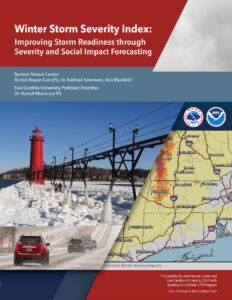 virtual focus groups, surveys and interviews to solicit feedback from professional users about the WSSI, how it would be used in decision-making and how its presentation could be improved to be more useful. Site locations included: Jackson, MS; Grand Rapids, MI; Hanford, CA; Omaha, NE; Boulder, CO; and Boston, MA. (Funded via NOAA Award Number NA20OAR4590355, September 1, 2020).
virtual focus groups, surveys and interviews to solicit feedback from professional users about the WSSI, how it would be used in decision-making and how its presentation could be improved to be more useful. Site locations included: Jackson, MS; Grand Rapids, MI; Hanford, CA; Omaha, NE; Boulder, CO; and Boston, MA. (Funded via NOAA Award Number NA20OAR4590355, September 1, 2020).
Research Study of Weather Prediction Center’s Winter Storm Severity Index (WSSI) for Alaska This mixed methods social science research study explored users’ needs for winter storm forecast information in Alaska and the potential utility of extending the Winter Storm Severity Index (WSSI) to Alaska. Through focus groups with professional stakeholders, surveys, and the Arctic Test Bed, the study developed recommendations for the WSSI Alaska product design (including what types of information/components are useful) that were shared with the WPC as they continue to develop the WSSI prototype for Alaska. (Funded via NOAA Award Number NA21OAR4590183, August 1, 2021).
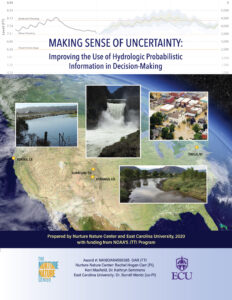 Making Sense of Uncertainty: Improving the Use of Hydrologic Probabilistic Information in Decision-Making
Making Sense of Uncertainty: Improving the Use of Hydrologic Probabilistic Information in Decision-Making
2018
Summary here.
Full report here.
Nurture Nature Center is delighted to release the final report for “Making Sense of Uncertainty: Improving the Use of Hydrologic Probabilistic Information In Decision-Making. This project was funded by a $320,540 grant from the National Oceanic and Atmospheric Administration (NOAA) to advance its social science research work around flood risk and flood forecasts. The grant supported a two-year mixed-methods social science research study of three forecast products to propose improvements to the display and communication of uncertainty and probabilistic information in hydrologic forecasts.
The project built on the findings from prior studies about the needs users have for hydrologic forecast information. The study engaged residents, emergency managers and water resource managers in California, Colorado and New York to learn how they use, understand and make decisions based upon flood forecast products, and specifically, how emerging probabilistic forecast capacity can be most useful. The products studied include the Advanced Hydrologic Prediction Service and specifically hydrographs produced through AHPS and at regional offices; emergency briefings that notify of impending flood events; and centrally, probabilistic forecasts issued through the emerging Hydrologic Ensemble Forecast System. NNC’s research team, including Dr. Burrell Montz of East Carolina University, has compiled a series of recommendations to NOAA about the best ways to use and improve upon these products to communicate flood risk.
Videos of Findings:
Study Overview HEFS Regional Recommendations HEFS National Recommendations HEFS Best Practices
Funds were made available through NOAA’s Office of Weather and Air Quality (OWAQ), which helps to improve weather forecast information and products for the nation by supporting high-impact weather and air quality research that ultimately leads to improvements in NOAA’s operational forecasts that help save lives and reduce property damage.
Lehigh Valley Live coverage of award available at: https://www.lehighvalleylive.com/easton/index.ssf/2018/09/how_this_easton_nonprofit_is_u.html
Media release from Congressman Cartwright available at: https://cartwright.house.gov/media-center/press-releases/cartwright-announces-320540-noaa-grant-for-nurture-nature-center
 Major Risks, Uncertain Outcomes: Making Ensemble Forecasts work for Multiple Audiences
Major Risks, Uncertain Outcomes: Making Ensemble Forecasts work for Multiple Audiences
Research Study of NWS Ensemble Forecast Products 2016
Full report here.
Through a grant to East Carolina University from NOAA’s CSTAR program, Nurture Nature Center in 2016 undertook its third social science research study of NWS Products. This project, “Major Risks, Uncertain Outcomes: Making Ensemble Forecasts work for Multiple Audiences,” used focus groups and surveys with residents and emergency managers in West Virginia and Maryland to understand how NWS’ Hydrologic Ensemble Forecast System works and could be improved for various audiences.
For those living or working in communities near rivers and streams, having inforfmation about forecast water levels is critical for planning. Property owners and emergency managers need to know if a flood is possible or imminent, while water resource managers need detailed information to control infrastructure and water supply. While National Weather Service (NWS) deterministic forecasts, represented as a hydrograph, are a go-to resource for decision makers, often it is useful to know the full range of possible levels that could occur, and understand the inherent uncertainty in river forecasts at longer timeframes. More…
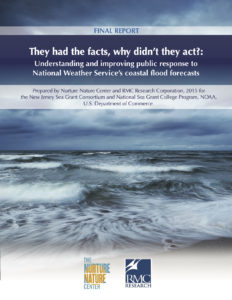 They had the facts, why didn’t they act?: Understanding and improving public response to National Weather Service’s coastal flood forecasts” (Coastal) 2014
They had the facts, why didn’t they act?: Understanding and improving public response to National Weather Service’s coastal flood forecasts” (Coastal) 2014
Full report here.
During acute coastal storm events, residents and emergency managers need specific, accurate, and timely information in order to make decisions about how to prepare for the threat of coastal flooding. But often at these times, they are inundated with information from a variety of sources, including social media, broadcast media, and government agencies. Amid all this noise, how do people make decisions about when to act, and how can they find the most important information quickly?
National Weather Service’s suite of coastal flood forecast and warning products, which are critical tools in this decision-making, was at the heart of NNC’s social science research project, “They Had the Facts, Why Didn’t They Act?” Through a series of focus groups and surveys, this study examined how residents and emergency managers in Ocean and Monmouth Counties use these and other flood forecast products to determine their response to coastal flooding. More…
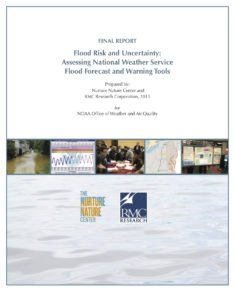 Flood Risk and Uncertainty: Assessing NWS Forecast and Warning Tools (Riverine) 2012
Flood Risk and Uncertainty: Assessing NWS Forecast and Warning Tools (Riverine) 2012
Full report here.
NNC’s social science project, “Flood Risk and Uncertainty: Assessing the National Weather Service’s Forecast and Warning Tools,” supports NOAA’s new Weather-Ready Nation initiative, designed to help the nation become better equipped to prepare for and respond to weather events.
The study, which includes focus groups and surveys of individuals living in flood-affected communities in New Jersey and Philadelphia, has two major research questions:
- How do people living in the Delaware River Basin use NWS flood forecast and warning tools in understanding their flood risk?
- How can these tools be improved so they better motivate flood preparedness and warning response?
NNC’s partners on this social science project include NWS Middle Atlantic River Forecast Center and the Weather Forecast Offices in Mt. Holly, NJ/Philadelphia, PA and Binghamton, NY, as well as Dr. Burrell Montz, a hazards researcher from East Carolina University with expertise in flooding issues. More…
